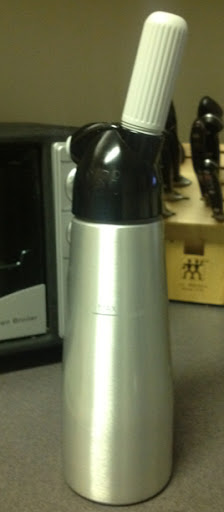Nitrogen cavitation is a scientific method used to disrupt the structure of cells. However, it can also be used for more sybaritic applications. In cooking, nitrogen cavitation can be used to infuse the flavor of aromatic compounds into another food or liquid. Think infused vodkas or rapid-marinated steak. In science labs nitrogen cavitation is done in what is termed a nitrogen bomb. For food, an easy and relatively cheap substitute is a whipped cream whipper and N2O chargers.

Although plenty of scientific articles explain how nitrogen cavitation works, not very many food articles do. Therefore, I’ve copied the way that a scientific article explains the process (slightly different than how most cooks will want to go about the process) for a more thorough understanding of the process.
“Cell disruption by nitrogen cavitation is based on rapid decompression of a cell suspension from within a pressure vessel. Nitrogen is dissolved in the cell suspension under high pressure within the cavitation chamber, or bomb. The cell suspension is then released dropwise through outflow tubing as the pressure is released. The nitrogen comes out of solution, forming bubbles that expand and rupture the cells. Shear stress also contributes to cell disruption, as bubbles stream through the solution, bathing the cells. The density of the bubbles is related to the amount of nitrogen dissolved in the solution, which is directly dependent on the pressure at which the chamber is equilibrated.” (Gottlieb et al 2000)
What does this mean in terms of cooking? What this is saying, in short, is that a chef can take a mixture of ingredients and place them inside a chamber. Think basil and vodka, chicken and marinade, and the like. Then, nitrogen gas (or nitrous oxide in the case of most chefs) will be released from a tank of some sort into the container. This will create a highly pressurized system in which the nitrogen gas is dissolved in the suspension of ingredients. When the pressure in the system is released, the nitrogen gas leaves the system, disrupting the cells. This creates an “infusion” of various ingredients into the desired food or drink.
My first attempt at nitrogen cavitation was to create infused vodka. After waiting a few weeks for my iSi Easy Whip Cream Whipper and iSi N20 Cream Whipper Chargers to arrive, I was understandably excited at their delivery. I went to the supermarket and bought a bunch of flavorful items I wanted to have my vodka flavored with.
In order to impart maximum flavor into the vodka, you want to increase the surface area of the ingredients being added. This can be done by chopping them up finely by hand or by blender.
The first ingredients that I decided to chop up were some of my favorite herbs—basil and mint:
 ——->
——-> 
 ——>
——> 
I then decided to try spicy flavors. I diced some jalapeño and habanero peppers next:

Other flavors that I experimented with were grated ginger, olives, mango, blackberries (put in the blender for increased surface area), and last but not least, bacon:

All of these ingredients were prepared and placed in bowls while I thought about complementary pairings. I ended up with the following combinations: Jalapeno-habanero-ginger-olive vodka, mint-mango vodka, basil-blackberry vodka, and bacon vodka.
After this, it was show time. The ingredients in each drink were added to the container. The amount of vodka added to the system varied, roughly proportional to how much space the ingredients themselves took up. Amounts varied from 100 mL to 200 mL.
When the ingredients and vodka were all in the “bomb,” the top was screwed on. The N2O gas charger was screwed into the system until a hissing noise indicted that the gas was released into the container. The system was shaken a few times and allowed to sit from 1-5 minutes. At the end of this “rest” time, the gas was vented. The container was then opened and the ingredients caught in a strainer as the vodka was allowed to collect.
Jalapeno-habanero-ginger-olive vodka:

Mint-mango vodka:

Basil-blackberry vodka:

Bacon vodka:

And as simply as that, a delicious array of vodkas were made!
Sources:
Roberta A. Gottlieb, Souichi Adachi, [20] Nitrogen cavitation for cell disruption to obtain mitochondria from cultured cells, In: John C. Reed, Editor(s), Methods in Enzymology, Academic Press, 2000, Volume 322, Pages 213-221, ISSN 0076-6879, ISBN 9780121822231, 10.1016/S0076-6879(00)22022-3. (http://www.sciencedirect.com/science/article/pii/S0076687900220223)
Leave a Reply